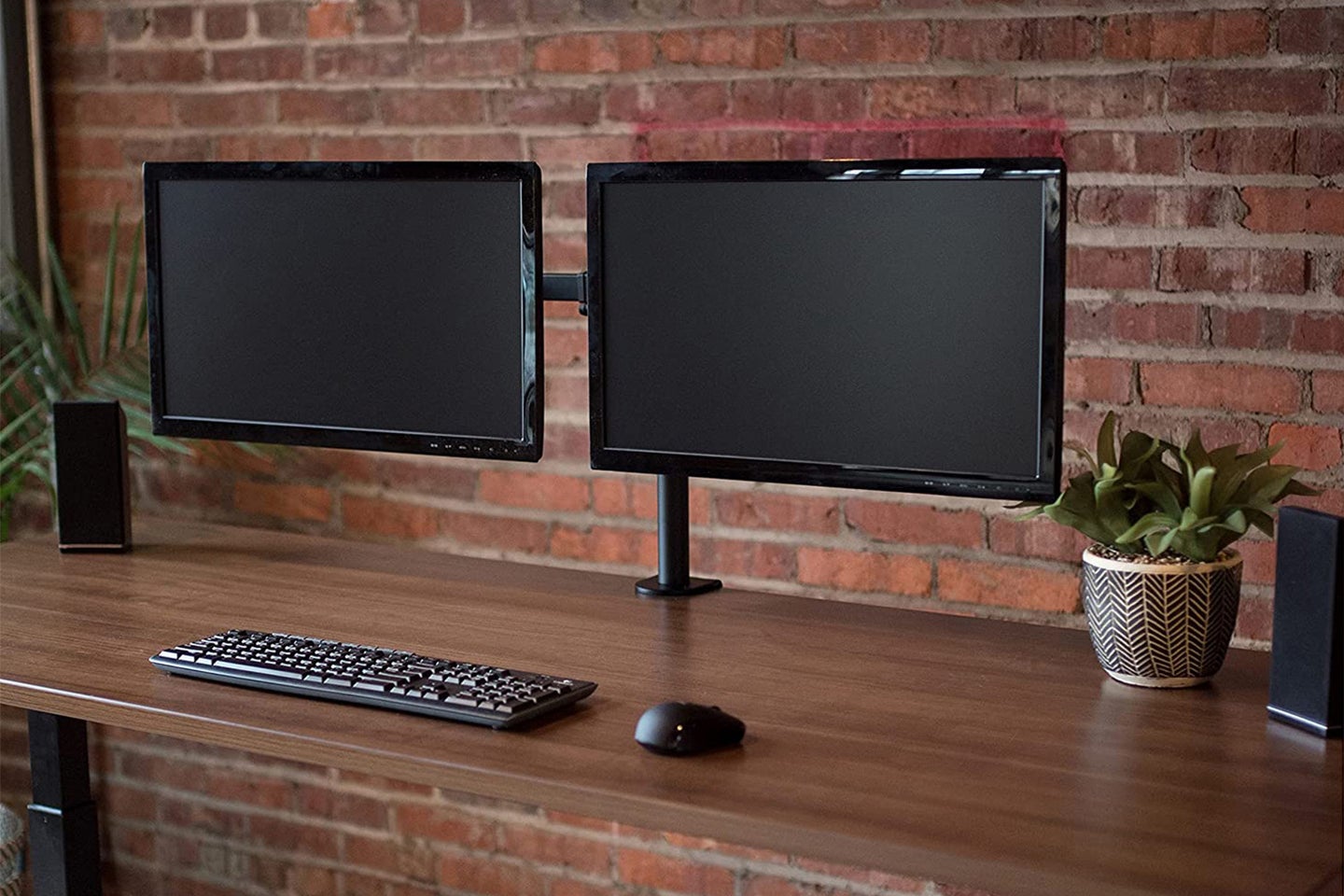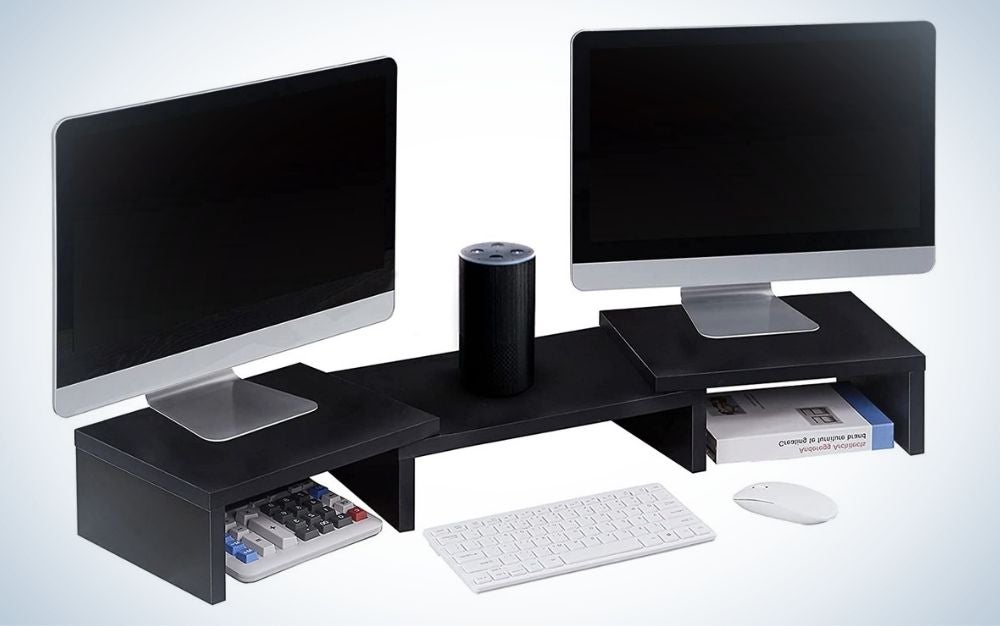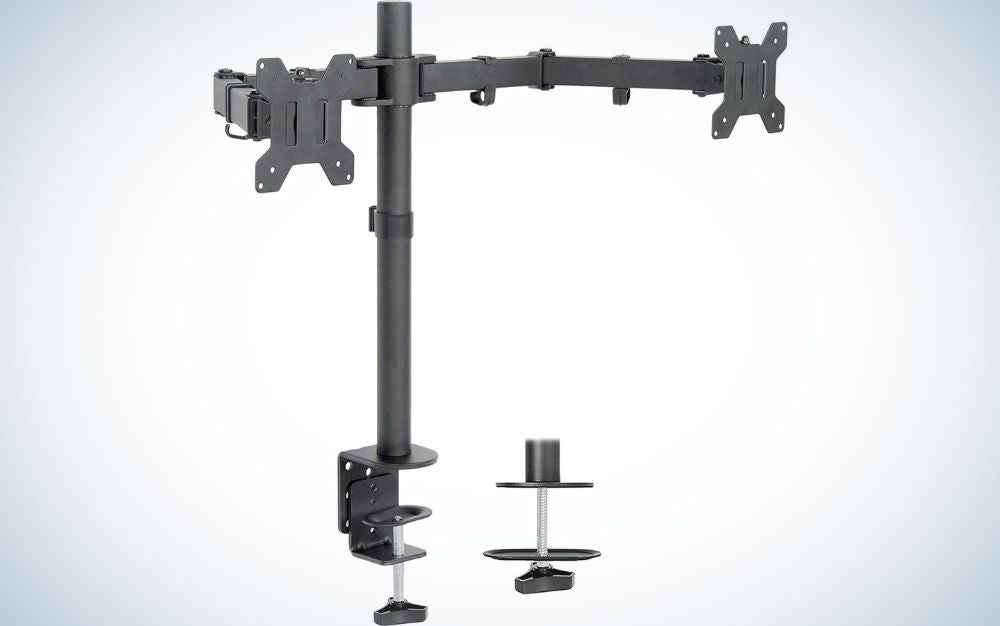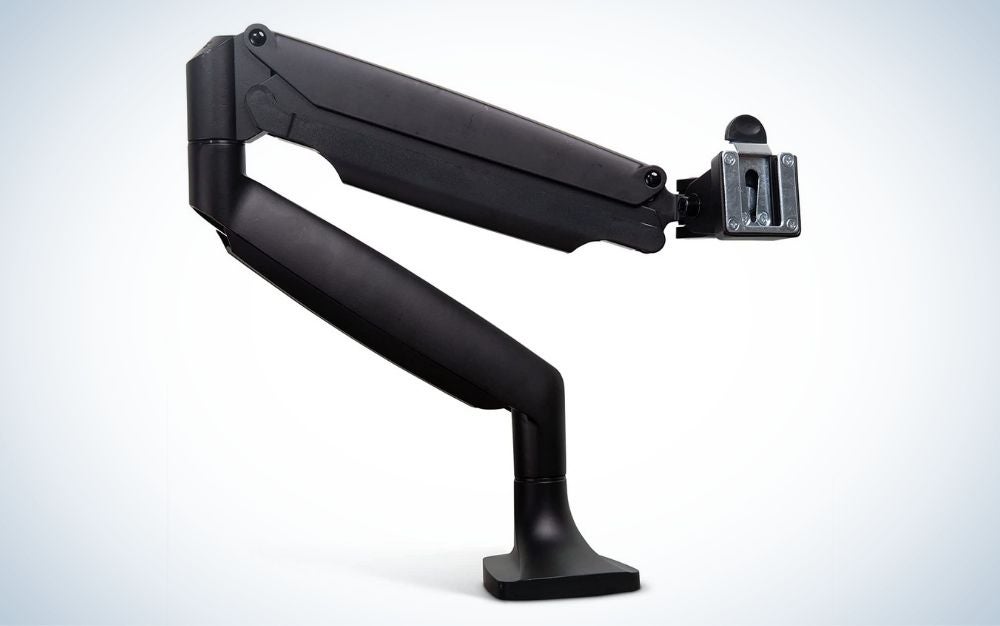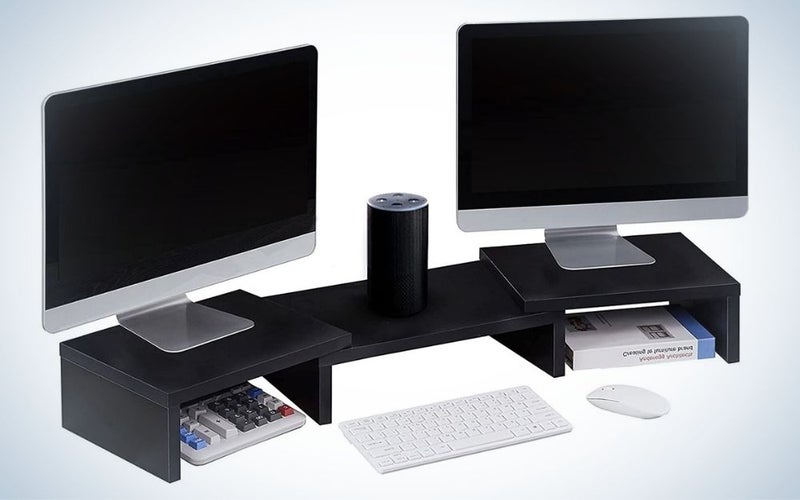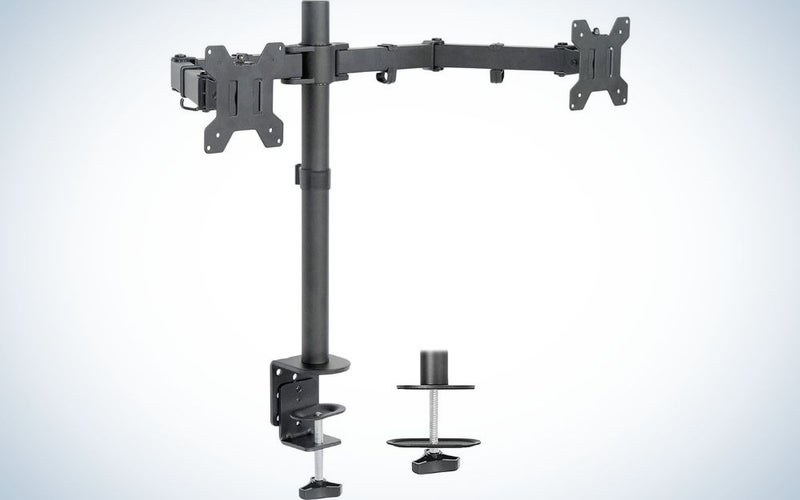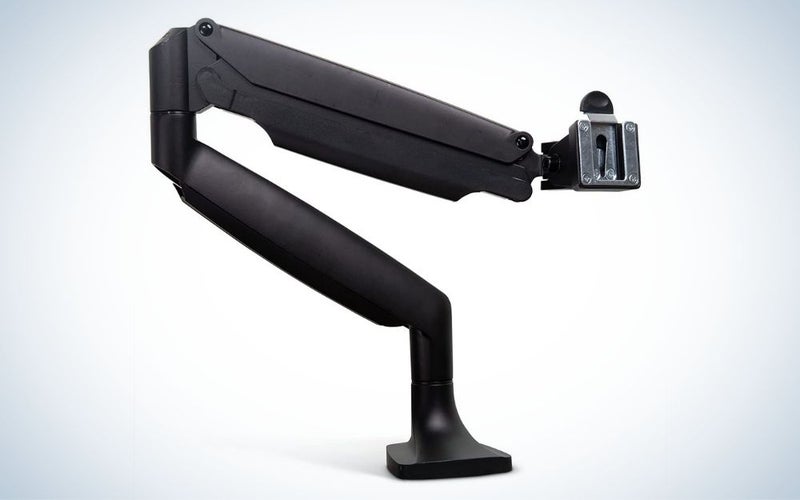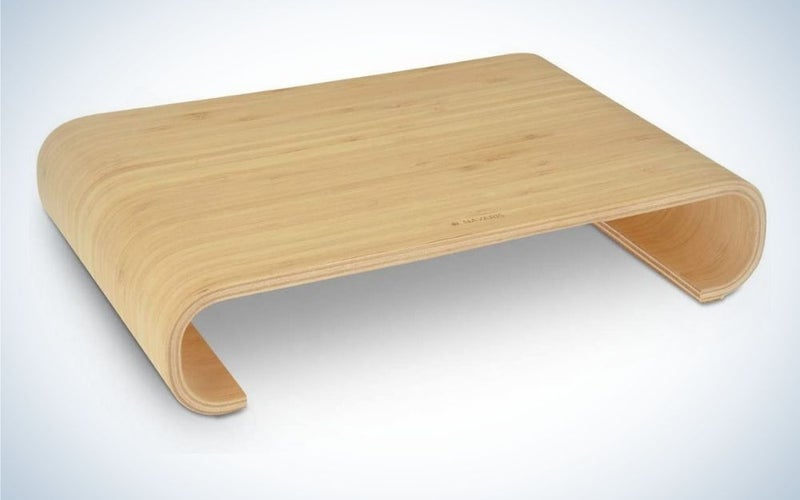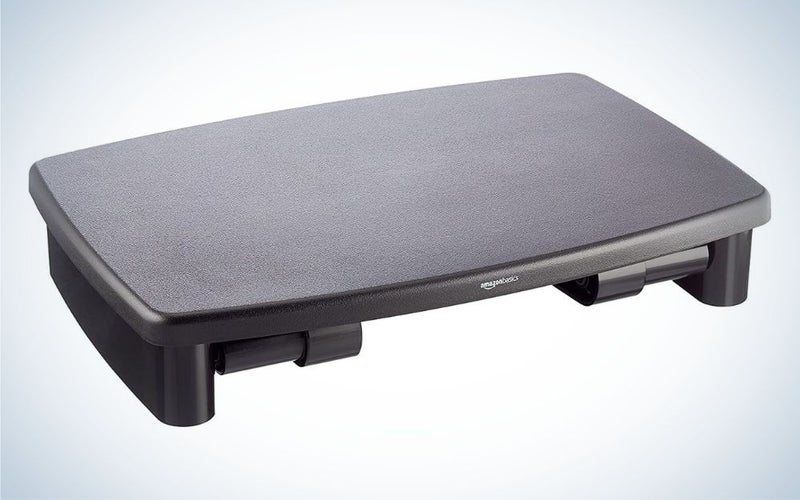We may earn revenue from the products available on this page and participate in affiliate programs. Learn more ›
Monitor stands–even simple ones–can drastically change the landscape of your workspace. Many of us have been stuck with less-than-ideal desk setups that leave us looking down for long periods, resulting in sore necks and backs. Monitor stands lift up your display, making your workstation more ergonomic. They can also free up space on your desk, which you will likely appreciate if you are still working from a corner of your living room due to lacking a dedicated office space. The best monitor stands will help your posture and make it easier to stare at that monitor.
- Best overall: SUPERJARE Dual Monitor Stand Riser
- Best for dual monitors: Vivo Dual Desk Mount
- Best adjustable: Fully Jarvis Monitor Mounting Arm
- Best wooden: Navaris Wood Monitor Stand Riser
- Best budget: Amazon Basics Adjustable Computer Monitor Riser Desk Stand
Methodology
The writers and editors at Pop Photo looked at far too many monitor stands when finding the best options available. We made sure to include all of the main types of stands–from basic risers to wall-mounted arms–to suit a variety of office setups. We also looked for a few design-focused options for those who like to curate their office style. Lastly, since monitor stands can be found at many different price points, we picked a variety to fit various budget needs.
The best monitor stands: Our picks
Now that we’ve sorted through some features and jargon, it’s time to dig into our picks. While we’ve sorted these into specific categories for different kinds of users, there’s often plenty of overlap so keep an open mind as you peruse the options.
Best overall: SUPERJARE Dual Monitor Stand Riser
SUPERJARE
Why it made the cut: It’s not overly fancy, but it offers the ability to use multiple monitors or even boost your laptop up as a second screen.
Key features
- Type: Dual monitor riser
- Max monitor weight: Not provided
- Compatible monitor size: Not provided
- Max height: 4.64 inches (side risers)
- Stand dimensions: 36.0″ × 9.2″ × 4.6″
Pros
- Customizable monitor angles
- Fits large monitors
- Variable length
- Available in different colors
- Very affordable
Cons
- Requires a large desk
The SUPERJARE Dual Monitor Stand is a simple riser-style stand. Though it isn’t all that fancy, it does offer three separate sections for customizability. You can adjust how long it is from 23.5 to 36 inches, depending on how big your desk is or if you want to use it for one or two monitors. You can also turn the two side pieces to an angle, putting your monitors at a more comfortable viewing angle.
Though the manufacturer doesn’t mention compatible monitor size or weight, it should hold a monitor that is plenty large as long as the base isn’t beyond 9.25 by 11.61 inches when the riser is extended. This stand is available in five different colors, so you can choose which best suits your office style. And, the price is low, so you don’t break the bank to have a more organized workspace.
Best for dual monitors: Vivo Dual Desk Mount
VIVO
Why it made the cut: The Vivo Dual Desk Mount is an affordable and easy to install dual monitor stand with full articulation and the ability to rotate monitors to vertical orientation.
Key features
- Type: Table mount stand
- Max monitor weight: 22 pounds per monitor
- Compatible monitor size: 13 to 27 inch screens
- Max height: 16 inches
- Stand dimensions: Variable
Pros
- Monitors can be rotated to veritcal
- Affordable
- Available in white and black
- Lots of articulation adjustments
Cons
- Cable management could be better
- Requires assembly
If you have two monitors that you need to mount and want simplicity, the Vivo Dual Desk Mount is the best option. It is very budget-friendly yet still offers plenty of great features. The single center pole results in a sleek, minimal design. You may get more movements out of a dual-arm setup, but they can look a bit clunky. And the +90° to -90° tilt, 180° swivel, and 360° rotation should be plenty of adjustment options for most people.
The stand is easy to install with the sturdy C-shaped clamp or an optional grommet. It even works with desks up to four inches thick. The Vivo is compatible with VESA 75 or 100 mounting systems and comes with all the hardware you need to install the mounting plates. It holds monitors up to 27 inches and 22 pounds, so it should hold most anything you want.
Best adjustable: Fully Jarvis Monitor Mounting Arm
Fully
Why it made the cut: With adjustments possible in almost any direction, including 23.8 inches of forward reach, as well as three color options, the Fully Jarvis Monitor Mounting Arm is the best for customizing your workstation.
Key features
- Type: Table mount stand
- Max monitor weight: 19.8 pounds
- Compatible monitor size: 13 to 32 inches
- Max height: 19.8 inches
- Stand dimensions: Variable
Pros
- Available in three colors
- Also comes in dual arm
- Adjustable in almost every way
- Integrated cable management
Cons
- A little pricey
The Fully Jarvis Monitor Mounting Arm is for those who want to move their monitor a lot or just want to truly fine-tune its position. It can rotate 360° to accommodate vertical displays, swivel 180° if you need others to see your screen, and tilt 45° to adjust your viewing angle. You can even rotate the base 270° and extend the arm out 23.8 inches. Plus, the arm is gas activated for very smooth movements.
This monitor arm comes fully assembled, which is a nice bonus. It has sleek integrated cable management to hide your cords. For installation, you can either mount it in grommet holes or clamp it to a desk up to 3.35 inches thick. It’s compatible with VESA 75mm and 100mm and can support monitors up to 32 inches and nearly 20 pounds.
The Jarvis isn’t just adjustable in terms of movement. You can also get it as a dual monitor setup or a dual arm to hold a monitor and laptop stand, and it is available in black, silver, or white.
Best wooden: Navaris Wood Monitor Stand Riser
Navaris
Why it made the cut: If you want to avoid plastic and metal, the Navaris Wood Monitor Stand Rise is an excellent choice.
Key features
- Type: Riser
- Max monitor weight: Not provided
- Compatible monitor size: Monitors with a max base size of 11.4 inches
- Max height: 2.8 inches
- Stand dimensions: 13.7 x 9.4 x 2.8 inches
Pros
- Attractive design
- Comes in four finishes
- Affordable
- Cork-lined bottom to prevent slipping
Cons
- Not very high
True to the riser style, the Navaris Wood rise is incredibly simple, but it is perhaps the most attractive monitor stand on the list. With sleek curves and beautiful wood grain, this stand will look right at home in a design-conscious office. It’s available in bamboo, black stained oak, white stained oak, or walnut, so you can choose the finish that best matches your style.
It isn’t a large riser, so it won’t take up much room on your desk. Your monitor base does need to be smaller than 11.4 inches, though, so you can’t use huge monitors on this unit. The feet are covered in cork so that the stand won’t slide should you accidentally bump it. It’s only 2.8 inches high, which doesn’t raise your monitor a ton, but it helps improve the viewing angle some and gives you a little of your desk space back underneath.
Best budget: Amazon Basics Adjustable Computer Monitor Riser Desk Stand
Amazon Basics
Why it made the cut: This Amazon Basics Monitor Riser Desk Stand can hold monitors as large as 32 inches, has an adjustable height, and is extremely affordable.
Key features
- Type: Riser
- Max monitor weight: 22 pounds
- Monitor size: Up to 32 inches
- Max height: 4.9 inches
- Stand dimensions: 11 x 16.1 inches (height variable)
Pros
- Adjustable height
- Sturdy
- Very affordable
Cons
- Not the most attractive
If you aren’t looking for anything fancy, this Amazon Basics monitor stand is the best riser for the price. This plastic stand can support up to a 32 monitor and 22 pounds. The thick legs make it extremely sturdy, and it has non-skid feet so that it doesn’t slide on your desk surface.
The height is adjustable from 2.6 to 4.9 inches, so you can pick whichever is best for viewing comfort. The riser style means that you will get back some desk space underneath the stand, so you can stash your fancy red stapler under there.
It’s not an overly appealing design, but the very affordable price sure adds to its attractiveness.
Things to consider before buying a monitor stand
Monitor stands can employ extremely basic designs, or offer complex solutions that have lots of specific specs and require installation. While the specifications are usually straightforward and easily understood, it can be confusing which things to pay attention to. Read on to find some of the key features when deciding on a monitor stand.
Stand type
Risers represent the simplest options, essentially acting like mini platforms for your monitors. They sit on your desk and lift your screen up by four or five inches. This type of stand creates a little bit of space underneath and raises your monitor to a more ergonomic height.
Freestanding desk stands attach to the back of your monitor and simply sit on your desk. Most monitors will come with a basic desk stand, but if you want an upgrade from that, some options let you adjust the height or angle of your screen. You can also find options that allow you to flip your monitor vertically.
If you want to free up more desk space, desk clamp monitors or wall mount stands will clear the most real estate. As the name implies, desk clamp stands clamp onto the edge of your desk. Wall-mounted monitor arms attach directly to the wall. Both of these take up minimal desk surface space, or none in the case of the wall mount, which is ideal if that is at a premium in your office setup.
Height
The height of your monitor stand matters for a few reasons. First, one of the most valuable aspects of a monitor stand is how it helps with ergonomics and viewing angle. If you get a monitor stand that is too short or too tall, you won’t actually be improving your desk setup to be more neck friendly.
If you opt for a riser style, one of the benefits is having a bit of room underneath the stand to give you more storage space. If your monitor riser is only a few inches off your desk, you won’t be able to utilize that space with much beyond a small notebook or your phone. If storage is important, and as long as the viewing angle won’t be too high, a higher riser will be optimal.
Monitor size
Monitor stands are all limited to how large a monitor they can support, both in terms of screen size and weight. Be sure that the monitor stand you are considering can support the weight and screen size of the monitor you have (or are contemplating buying) before hitting that purchase button. If you’re buying a stand for an odd-shaped monitor like a super-wide, make sure to figure that extra screen space into your calculations.
Adjustability
If you want the ability to customize the position of your monitor or desk setup, be sure to look for a stand with adjustability. Some only are adjustable in terms of length, some allow height adjustments, and others–usually monitor arms–can rotate and tilt in multiple directions for full control. Arms provide 360 degrees of movement, but they’re more expensive and trickier to set up. If you’re just looking for a little extra height, you’ll likely be just fine with something simple.
Additional features
Some monitor stands will have additional features to help with organization or productivity. Keep an eye out for the things below if they are important to you.
- Storage: Some stands will offer drawer space or built-in organizational features to stash pens, notebooks, tablets, or hard drives.
- Cable management: Primarily found in monitor arms, cable management helps hide all those ugly cords from view and also keeps them tidy and untangled.
- Hubs: If you want additional ports for things like hard drives and mics, look for a monitor stand that doubles as a USB hub.
- Number of monitors: Be sure to look at stands that support the number of monitors that you will have in an ergonomic and user friendly way.
FAQs
Q: How much does a monitor stand cost?
How much a monitor stand costs varies greatly, depending on the materials it is made of, the size and weight it can support, fancy bells and whistles it may have, and the stand style. But, broadly speaking, you can find a monitor stand anywhere from $15 to almost $300.
Q: Is it good to have a monitor stand?
It is good to have a monitor stand. They can have lots of benefits, depending on the type you choose. They can free up space on your desk, offer storage space or other decluttering features, and perhaps most importantly, make your workspace more ergonomic or versatile.
Q: Does a monitor stand help with posture?
A monitor stand can help with posture. Looking down for long periods is not good for the neck and shoulders and can cause problems over time. By lifting your monitor even slightly, you will be able to look more straight ahead when working, which will lead to better posture.
Q: Can you put a laptop on a monitor stand?
You can put a laptop on a monitor stand if it is the riser variety. Not all risers will be large enough for laptops, especially if you have a larger laptop, but many will be. You will, however, want to choose a riser with ventilation holes, as you could have overheating problems if it is on a solid surface. Better ventilation for your laptop equals a happier laptop.
Final thoughts on the best monitor stands
There are seemingly endless options for monitor stands with all sorts of different features. No matter which you choose, be sure it makes your work setup more comfortable for the inevitable long hours you’ll spend staring at it.
